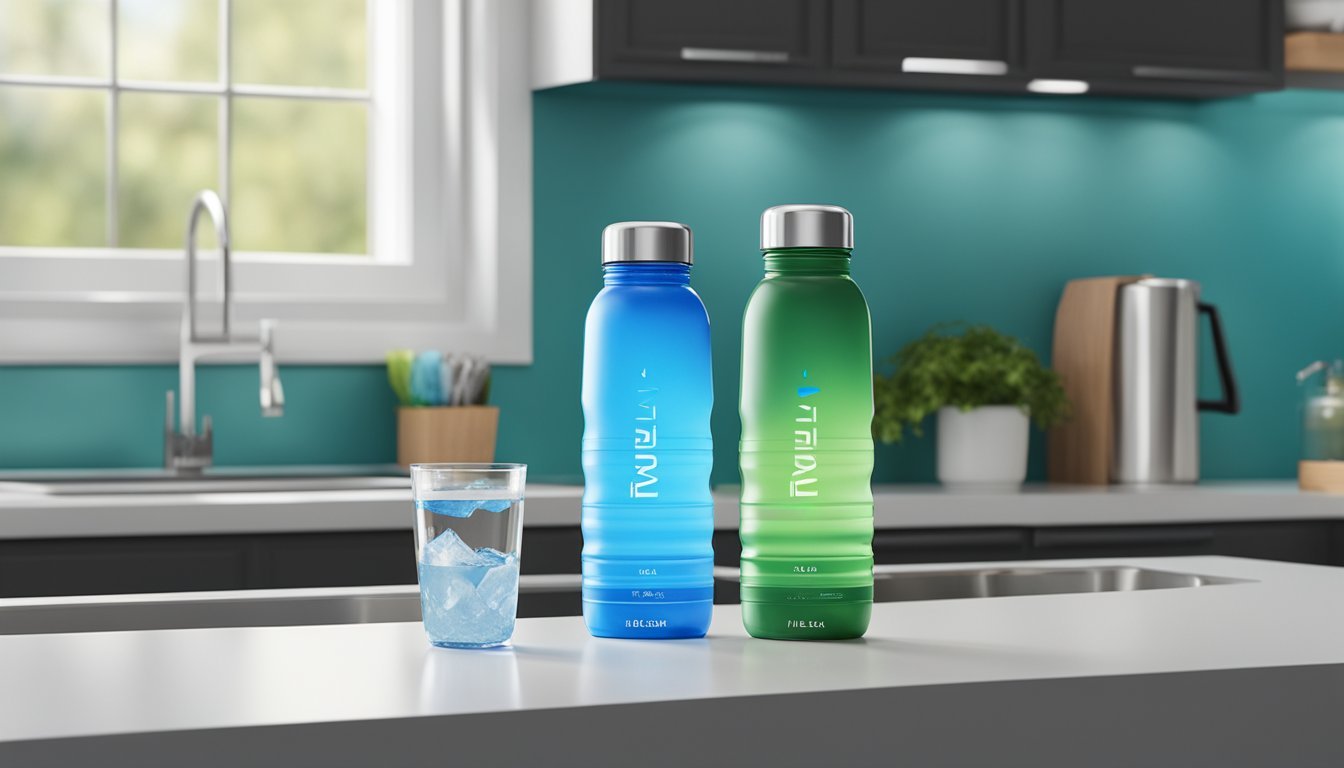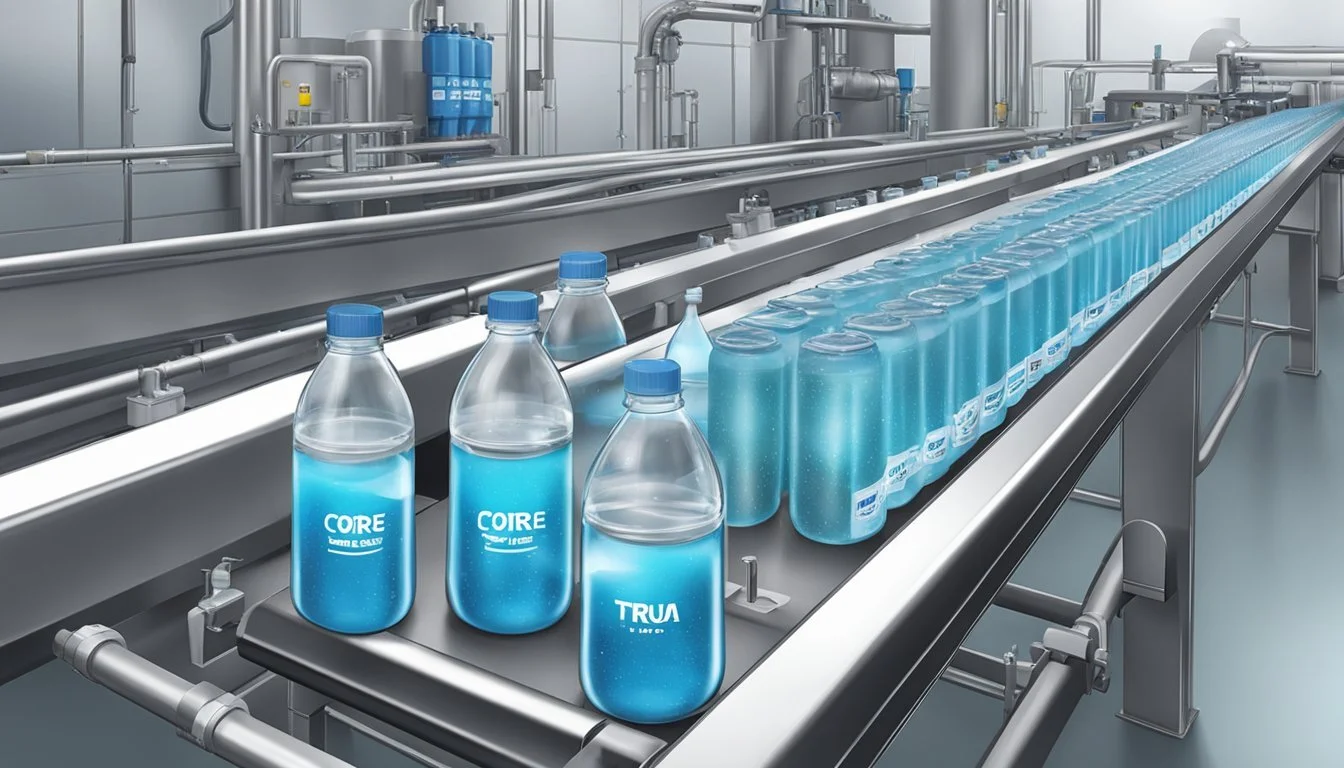Core Hydration vs. Tru Alka
Which Bottled Water is Better and Why?
Choosing between Core Hydration and Tru Alka bottled water can be a tough decision for those looking to optimize their hydration. Core Hydration prides itself on being balanced with a perfect pH of 7.4, which aligns closely with the body's natural pH level. This neutral to slightly alkaline water is packaged in a distinct, ergonomically designed bottle that fits comfortably in hand.
On the other hand, Tru Alka offers purified water with a grounding alkalinity, focusing on delivering a flat and straightforward hydration experience. While Core Hydration strives for an appealing taste and convenient packaging, Tru Alka emphasizes the purity and simplicity of its water.
When it comes to choosing based on pH balance and packaging appeal, Core Hydration stands out with its neutral pH and ergonomic design. For those prioritizing purity with a subtle taste profile, Tru Alka may be the better choice. Reading further will help you gain a comprehensive understanding of which option aligns best with your hydration goals.
Understanding Bottled Water
Many consumers choose bottled water for its convenience and perceived quality. This section will explore the types of bottled water and the regulations governing their safety and quality.
Types of Bottled Water
Bottled water comes in several varieties, each with unique characteristics. Spring water originates from underground formations and flows to the surface naturally. Mineral water contains no less than 250 parts per million total dissolved solids from natural sources and retains the original mineral content. Purified water undergoes processes such as distillation, deionization, or reverse osmosis to remove impurities.
Core Hydration and Tru Alka are examples of purified water, often with added electrolytes and minerals. Core Hydration boasts a balanced pH level that aims to mirror the body's natural pH, while Tru Alka emphasizes its alkaline nature for better hydration.
Regulations and Standards
Regulatory bodies like the FDA in the United States ensure bottled water meets specific standards for quality and safety. These standards dictate the permissible levels of contaminants and require that the source be protected from pollution. Water must be processed, bottled, and labeled in compliance with these regulations.
Brands like Core Hydration and Tru Alka undergo strict testing to ensure safety and meet FDA regulations. Informative labeling, although sometimes incomplete on precise mineral content, offers transparency in ingredients, providing consumers a safeguard against harmful additives.
Comparing Water Quality
Both Core Hydration and Tru Alka claim to offer high-quality bottled water with health benefits. This section will explore their pH levels, mineral content, and electrolyte enhancements to help decide which is better.
pH Levels and Alkalinity
Core Hydration's water has a pH of 7.4, designed to match the body’s natural pH balance. This level is considered neutral to slightly alkaline. Tru Alka, on the other hand, typically boasts a higher pH level, often around 9+. This higher alkalinity is believed by some to offer additional health benefits, such as improved hydration and acid-neutralizing properties.
Both brands cater to different preferences in pH levels. Core Hydration focuses on a balance that aligns with the body's natural state, while Tru Alka targets those looking for more alkaline water.
Mineral Content
Mineral content plays a crucial role in the quality and taste of bottled water. Core Hydration goes through a rigorous purification process using reverse osmosis, removing impurities while maintaining essential minerals like calcium, magnesium, and potassium. These minerals contribute to the taste and offer nutritional benefits.
Tru Alka also emphasizes the presence of beneficial minerals, often including higher concentrations due to its higher pH level. The specific minerals in Tru Alka's water vary but generally include magnesium, calcium, and potassium.
For those who prioritize mineral intake, Tru Alka may offer a slight edge due to higher concentrations.
Electrolyte Enhancement
Electrolyte enhancement is another critical factor in comparing these bottled waters. Core Hydration includes an electrolyte and mineral blend that aims to enhance hydration and improve taste. This blend includes potassium, calcium, and magnesium, which support various bodily functions.
Tru Alka also features enhanced electrolytes, designed to optimize hydration and replace essential minerals lost through sweat and daily activities. This can be particularly beneficial for athletes or those with active lifestyles.
In summary, both brands provide electrolyte-enhanced water, but Core Hydration focuses on a balanced blend, while Tru Alka aims for higher concentrations of electrolytes.
Health and Hydration
Core Hydration and Tru Alka bottled waters offer hydration solutions with specific health benefits, targeting different aspects of body function and physical performance.
Hydration and Body Function
Hydration is crucial for maintaining body function. Core Hydration claims to balance its water to match the body's natural pH level, which is around 7.4. This balancing can potentially aid in maintaining homeostasis. Tru Alka, on the other hand, emphasizes a grounding alkalinity, which some believe helps neutralize excess body acidity.
Both brands provide purified water, free from most contaminants found in tap water. The addition of electrolytes in Core Hydration supports rehydration by replenishing essential minerals lost through sweat. Similarly, Tru Alka’s alkalinity may assist in better hydration due to its pH-adjusted properties.
Impact on Physical Performance
Proper hydration significantly impacts physical performance, particularly in athletes. Core Hydration’s electrolytes, including potassium and magnesium, play a role in preventing muscle cramps and fatigue during intense activities. This makes it a preferred choice for those engaging in strenuous exercise.
Tru Alka’s alkaline properties might offer distinct benefits for physical endurance by helping to reduce muscle acid build-up. Some athletes find alkaline water beneficial in minimizing lactic acid accumulation, thus reducing post-exercise soreness and improving recovery times.
Potential Health Risks
Overconsumption of any water, even purified bottled water, can lead to imbalances. While both Core Hydration and Tru Alka cater to health enthusiasts, there are potential risks associated with excessive alkaline water intake, such as altering stomach acidity, which can affect digestion.
Additionally, reliance solely on bottled water overlooks the accessibility of treated tap water in many regions. Consumers need to balance their choice of hydration sources to avoid missing out on the natural minerals present in tap water. Both Core Hydration and Tru Alka offer benefits but should be part of a varied and balanced approach to hydration.
Manufacturing Processes
Understanding the manufacturing processes of Core Hydration and Tru Alka is crucial for making an informed choice. This section explores the subtleties of their reverse osmosis and filtration and ionization and water quality, highlighting what sets each brand apart.
Reverse Osmosis and Filtration
Core Hydration employs a seven-stage purification process that includes reverse osmosis. This advanced method removes contaminants, ensuring the water is pure and clean. The seven stages typically involve:
Pre-filtration to remove large particles
Activated carbon filters for chlorine and organic compounds
Reverse osmosis to eliminate dissolved solids
These steps make Core Hydration's water notably pure. Tru Alka also uses reverse osmosis but combines it with alkaline enhancement. This dual approach not only purifies the water but also increases its pH, which some consumers prefer for its potential health benefits.
Ionization and Water Quality
Core Hydration's process includes ionization steps to balance electrolytes, enhancing the water's taste without altering its natural composition excessively. Electrolytes such as calcium, potassium, and magnesium are added post-filtration to create a smooth and refreshing taste.
On the other hand, Tru Alka leverages ionization to increase the water's alkalinity. This ionization method modifies the water's pH to be more alkaline, typically aiming for a pH of 8 or higher. This process is crucial for those seeking alkaline water's purported detoxifying and hydrating benefits.
Both brands emphasize different aspects of their ionization techniques, reflecting their unique selling propositions based on consumer preferences.
Taste Profile
When choosing between Core Hydration and Tru Alka, the taste of the water is a critical factor that influences the consumer's decision. Both brands offer distinct flavor profiles influenced by their unique mineral compositions and pH levels.
Importance of Taste
The taste of bottled water might seem subtle, but it plays a crucial role in consumer preference. Even though water is generally considered flavorless, subtle variations in mineral content and pH can create noticeable differences in taste. For instance, a water sommelier might describe Core Hydration as having a crisp and clean flavor due to its balanced pH of 7.4.
Tru Alka, with its higher alkalinity, might have a smoother and slightly sweeter taste. Conducting a taste test can help determine which flavor profile consumers prefer, especially for those sensitive to different mineral compositions.
Factors Affecting Taste
Several factors contribute to the taste of bottled water. Mineral content is paramount, with minerals like magnesium and calcium adding subtle sweetness or crispness. Core Hydration's neutral pH and moderate mineral content offer a clean, refreshing taste.
Alkalinity also affects taste. Tru Alka's higher pH level, often above 8, imparts a smoother, less acidic flavor that some find more refreshing. Additionally, filtration methods, such as vapor distillation or reverse osmosis, can remove impurities and shape the water's final taste profile. Each brand's unique process results in distinct flavor experiences, catering to varied consumer preferences.
Environmental Considerations
When comparing Core Hydration and Tru Alka, the environmental impact of their packaging materials and waste management practices are crucial. These factors influence the sustainability and carbon footprint of these bottled water brands.
Bottling Materials and BPA
Core Hydration uses plastic bottles that are BPA-free, ensuring that the packaging materials do not contain harmful chemicals. This is important as BPA (Bisphenol A) has been linked to various health risks. Tru Alka also adheres to similar standards, using BPA-free plastic for their bottles.
Using BPA-free materials reduces the environmental and health impact, making both brands more appealing for eco-conscious consumers. The type of plastic used, typically PET (polyethylene terephthalate), is chosen for its durability and lower environmental footprint compared to other plastics.
Recycling and Waste Management
In terms of recycling, both Core Hydration and Tru Alka emphasize recyclable packaging. Core Hydration bottles are designed to be easily recyclable, supporting waste management practices aimed at reducing landfill contributions. They often encourage consumers to properly recycle their bottles by providing clear instructions on the label.
Tru Alka also prioritizes recycling, incorporating recycled materials in their packaging to minimize waste. They actively participate in initiatives to promote sustainability and reduce their overall carbon footprint. Effective recycling and waste management not only lower environmental impact but also foster a circular economy where packaging materials are continually reused.
Overall, both brands show a commitment to environmental sustainability through their choice of packaging materials and active participation in recycling programs.
Comparative Market Analysis
In the bottled water industry, Core Hydration and Tru Alka compete across several dimensions, including brand positioning and consumer preferences. This analysis looks at how each brand stands in the market and what drives their customer base.
Brand Positioning
Core Hydration positions itself as a premium bottled water with a perfect pH balance of 7.4, mirroring the body's natural pH. This brand targets health-conscious consumers who value hydration that aligns with their body's chemistry.
Tru Alka enters the market emphasizing its high alkaline content, typically with a pH of 9 or above. It appeals to a niche market of fitness enthusiasts and those seeking potential health benefits from higher alkalinity levels.
Core Hydration and Tru Alka face competition from brands like Smartwater, which offers an alkaline version, and Essentia, known for its high pH water. Their market strategies differ: Core Hydration leverages its balanced pH, while Tru Alka capitalizes on the alkaline trend.
Consumer Preferences
Consumers of Core Hydration prioritize taste and the promise of balanced pH, frequently mentioned in surveys and reviews. They often choose Core for its clean, smooth flavor and the perceived health benefits of balanced water.
Tru Alka's customers look for high alkalinity levels, believing in the benefits of alkaline water for activities like detoxification and improved hydration during workouts. This brand sees a stronger following among fitness circles and those looking for specific health benefits.
Both brands confront strong preferences for alternatives like Fiji and Evian, which are popular for their natural sourcing and purity. While Core Hydration focuses on balance, Tru Alka meets a growing demand for high pH water, helping each brand carve out its unique market share.
Consumer Information
Consumers looking for balanced hydration should consider factors like price, bottle design, and convenience when choosing between Core Hydration and Tru Alka. Both brands offer distinct features and advantages that cater to different needs and preferences.
Price Comparison
Core Hydration bottles are typically priced between $1.50 and $2.50 per bottle, depending on the size and retailer. Offers can sometimes bring the price down when buying in bulk. Availability is broad, with the bottles being found at most major grocery stores and online.
Tru Alka generally falls into a similar price range, often between $2.00 and $3.00 per bottle. Special discounts may apply for larger purchases. This brand is also widely available, but some consumers find it more often in health food stores and specialty retailers.
Bottle Design and Convenience
Core Hydration sports a sleek, ergonomic bottle design that is easy to grip and carry. Many consumers appreciate its wide-mouth opening, which makes drinking and adding ice easy. The bottles are made from recyclable plastic, emphasizing sustainability.
Tru Alka has a more traditional cylindrical design that is also easy to handle. They offer reusable bottle options, including glass bottles, which appeal to environmentally conscious consumers. These bottles often feature a convenient screw-top, making them secure for on-the-go use.
Both brands aim to make safe drinking water accessible, but their bottle designs cater to different preferences and needs.
More About Core Hydration
Acqua Panna vs Core Hydration: Which Bottled Water is Better?
Boxed Water vs Core Hydration: Which Bottled Water is Better?
Core Hydration vs Alkaline88: Which Bottled Water is Better?
Core Hydration vs Aqua Carpatica: Which Bottled Water is Better?
Core Hydration vs Cascade Mountain: Which Bottled Water is Better?
Core Hydration vs Castle Rock: Which Bottled Water is Better?
Core Hydration vs CBD Living: Which Bottled Water is Better?
Core Hydration vs Crystal Geyser: Which Bottled Water is Better?
Core Hydration vs Crystal Lake: Which Bottled Water is Better?
Core Hydration vs Essence pH10: Which Bottled Water is Better?
Core Hydration vs Hawaii Volcanic: Which Bottled Water is Better?
Core Hydration vs Hawaiian Springs: Which Bottled Water is Better?
Core Hydration vs Ice Mountain: Which Bottled Water is Better?
Core Hydration vs Icelandic Glacial: Which Bottled Water is Better?
Core Hydration vs Just Water: Which Bottled Water is Better?
Core Hydration vs Kirkland Signature: Which Bottled Water is Better?
Core Hydration vs Liquid Death: Which Bottled Water is Better?
Core Hydration vs Mountain Valley Spring Water: Which Bottled Water is Better?
Core Hydration vs Nestle Pure Life: Which Bottled Water is Better?
Core Hydration vs Open Water: Which Bottled Water is Better?
Core Hydration vs Poland Spring: Which Bottled Water is Better?
Core Hydration vs Proud Source: Which Bottled Water is Better?
Core Hydration vs Purely Sedona: Which Bottled Water is Better?
Core Hydration vs Richard's Rainwater: Which Bottled Water is Better?
Core Hydration vs San Pellegrino: Which Bottled Water is Better?
Core Hydration vs Simple Truth: Which Bottled Water is Better?
Core Hydration vs Smartwater: Which Bottled Water is Better?
Core Hydration vs Solan de Cabras: Which Bottled Water is Better?
Core Hydration vs Talking Rain AQA: Which Bottled Water is Better?
Core Hydration vs Topo Chico: Which Bottled Water is Better?
Core Hydration vs Weird Water: Which Bottled Water is Better?
Core Hydration vs Whole Foods 365: Which Bottled Water is Better?
Core Hydration vs Whole Foods Italian Still Mineral water: Which Bottled Water is Better?
Core Hydration vs Zephyrhills: Which Bottled Water is Better?
More About Tru Alka
Hawaiian Springs vs Tru Alka: Which Bottled Water is Better?
Icelandic Glacial vs Tru Alka: Which Bottled Water is Better?
Mountain Valley Spring Water vs Tru Alka: Which Bottled Water is Better?
Nestle Pure Life vs Tru Alka: Which Bottled Water is Better?
Tru Alka vs Cascade Mountain: Which Bottled Water is Better?
Tru Alka vs Kirkland Signature: Which Bottled Water is Better?
Tru Alka vs Richard's Rainwater: Which Bottled Water is Better?
Tru Alka vs Talking Rain AQA: Which Bottled Water is Better?
Tru Alka vs Whole Foods Italian Still Mineral water: Which Bottled Water is Better?





